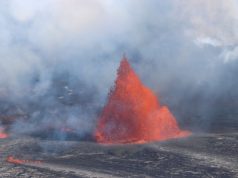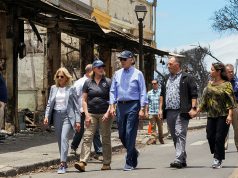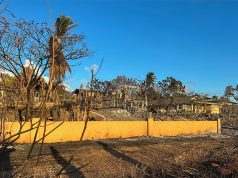
Wildfires on Hawaii’s Maui have killed at least 96 people, forced tens of thousands of residents and tourists to evacuate the island and devastated the historic resort city of Lahaina. It’s the deadliest U.S. wildfire in more than a century. The Big Island of Hawaii is also battling wildfires, which have caused no fatalities.
Here are some key questions and answers about the blazes:
Are the Maui fires still burning?
Firefighting crews were still battling flare-ups. The largest fire in Lahaina is 85% contained and has burned 2,170 acres (880 hectares), Maui County said. Another fire in upcountry/Kula is 60% contained and has charred 678 acres (270 hectares). Smaller fires elsewhere are now 100% contained.
The fires, which started the night of August 8, wreaked widespread destruction in Lahaina. The city of about 13,000 people on northwestern Maui was once a whaling center and the Hawaiian Kingdom’s capital, and now draws 2 million tourists a year.
Cadaver dogs searched Lahaina’s charred ruins for victims, and officials said it was likely the number of dead would rise.
The Federal Emergency Management Agency (FEMA) estimates it will cost $5.5 billion to rebuild the town.
How does the death toll compare with that of other fires?
The Maui blaze is the deadliest U.S. wildfire since 1918, when northern Minnesota’s Cloquet Fire, which raged for more than four days, claimed 453 lives, according to the National Fire Protection Association (NFPA). The deadliest wildfire in U.S history, Wisconsin’s Peshtigo fire in 1871, killed 1,152.
Hawaii’s fires also constitute the most lethal disaster to hit the islands since a tsunami that killed 61 people in 1960, a year after Hawaii became a U.S. state.
What about Hawaii’s disaster warning sirens?
Some Maui residents have questioned whether more could have been done to warn them. Witnesses said they had little warning, describing their terror as the blaze destroyed Lahaina in what seemed like minutes. Some people dove into the Pacific Ocean to escape.
Sirens stationed around the island — intended to warn of impending natural disasters — never sounded, and widespread power and cellular outages hampered other forms of alerting.
Hawaii Governor Josh Green vowed on Sunday to investigate the response and emergency notification systems.
How did the fires start?
The causes of the fires have not yet been determined. The National Weather Service had issued warnings for the Hawaiian Islands for high winds and dry weather — conditions ripe for wildfires.
Nearly 85% of U.S. wildfires are caused by humans, according to the U.S. Forest Service. Natural causes include lightning and volcanic activity.
In Hawaii, less than 1% of fires are due to natural causes, according to Elizabeth Pickett, co-executive director of the Hawaii Wildfire Management Organization. The Hawaiian Islands have six active volcanoes, including one on Maui.
The spread of flammable non-native grasses in areas of former farmland and forest has created large amounts of small, easily ignited materials that increase the risk and severity of fire.
Record-setting heat this summer has contributed to unusually severe wildfires in Europe and western Canada. Scientists say climate change, driven by fossil fuel use, has led to more frequent and more powerful extreme weather events.
Where is Hawaii located?
Hawaii, which became the 50th U.S. state in 1959, is an archipelago located about 2,000 miles (3,200 km) west of the U.S. mainland. It is made up of eight main islands, including Hawaii, known as the Big Island. The island of Maui lies to the north and west of the island of Hawaii.
— Compiled by Jonathan Oatis; Editing by Lisa Shumaker









